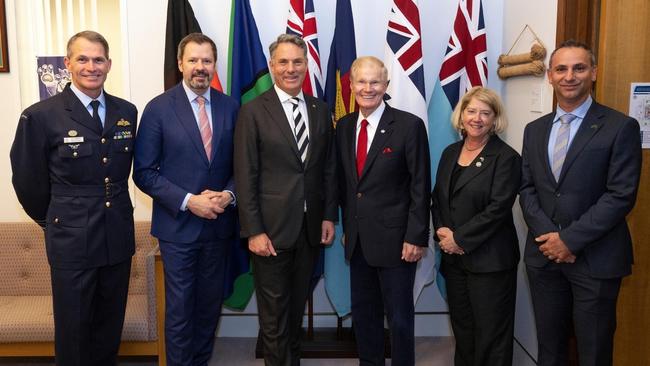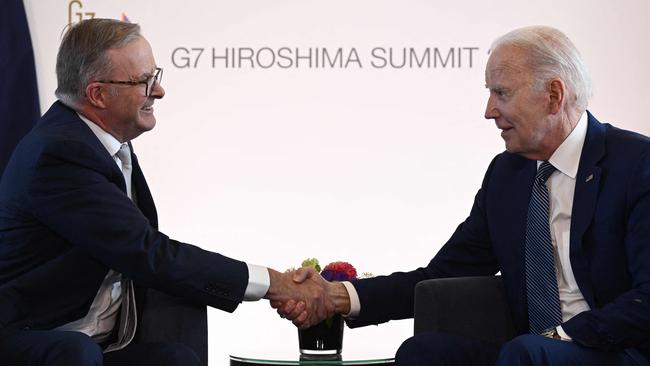NASA, White House kept ‘in the dark’ on Labor’s secret $1.2bn space cut, emails show
Embassy officials were instructed to keep the White House in the dark over a secret decision to cut a $1.2bn NASA-backed satellite program, sparking concerns over Labor’s commitment to space.

Australian embassy officials were instructed to keep the White House in the dark over a secret budget decision to cut a $1.2bn NASA-backed sovereign satellite program.
Advisers to Industry Minister Ed Husic told Washington embassy officials that Mr Husic and the Prime Minister’s office did not want the Biden administration and NASA to know about the terminated program until hours before it was announced on June 29.
Chains of emails and briefing documents released under Freedom of Information show high-level exchanges about when to tell the White House National Space Council, chaired by Vice-President Kamala Harris, the US Geological Survey and NASA.
The emails show planned meetings to brief US officials were cancelled after pressure from Canberra and that embassy officials had expressed a “strong feeling” the White House should be informed about axing the National Space Mission for Earth Observation program.
The satellite funding was secretly terminated in the May 9 budget – a decision viewed by the Coalition and industry as “political” – 11 days before Anthony Albanese and Joe Biden met on the sidelines of the G7 summit in Japan and jointly endorsed “reaching new frontiers in space”.
On May 20, Mr Albanese and the US President said space collaboration – a key pillar under the AUKUS and Quad partnerships – presented a “rich opportunity to build high-skilled, well-paying jobs and increase investment between our countries”.
Mr Albanese and Mr Biden – who are expected to meet at the G20 summit in India on the weekend – signed an agreement-in-principle on a technology safeguards agreement and announced one of three global NASA Artemis Lunar Exploration ground stations would be based in Australia.
The decision to cut the satellite program, funded in the Morrison government’s final budget, was understood to be well-progressed when US ambassador Caroline Kennedy hosted NASA administrators Bill Nelson and Pam Melroy in Canberra and Adelaide, where the Australian Space Agency is located.
As the cabinet expenditure review committee finalised $17.8bn in savings and reprioritised spending, Mr Nelson and Ms Melroy on March 23 met Mr Husic, Defence Minister Richard Marles, Air Force Chief Robert Chipman and Australian Space Agency head Enrico Palermo at Parliament House. The high-level delegation, which had travelled to Australia to shore up space investments, was not informed of the funding cut.
The NSMEO – formally endorsed by NASA via an agreement signed with the Australian Space Agency at the Colorado Space Symposium in April 2022 – would have delivered four locally designed and built satellites between 2028 and 2033.
Defence and space industry sources said that while NSMEO satellites were primarily for civil and commercial applications – including strengthening the nation’s response to climate change, natural disasters and maritime threats – they would have also blazed the path for dedicated military satellites. Over several decades, Australia has exclusively relied on the US, Japan and Europe to provide land and weather satellite imagery virtually for free. International partners had encouraged Australia to actively fund and participate in the earth observation satellite network.
FOI documents reveal how the Albanese government sought to keep the NSMEO axing from US officials ahead of the June 29 announcement. The decision to terminate the program was made months before but kept secret, with $452.4m in reprioritised funding over the forward estimates hidden in a “decisions taken but not yet announced” budget line item.
On June 23, the week before publicly announcing the NSMEO was cut, Mr Husic’s office sent an email to Australian embassy officials about timing and when US authorities should be alerted.
“Wednesday 28th June (AU time): DC Post to notify US system under strict embargo, only those who need to know,” the email said.
“Note that it was an express preference from the Minister and PMO (Prime Minister’s Office) that US be notified no earlier than Wednesday AU time, and we have communicated that with the Foreign Minister’s Office.”
On June 27, Mr Husic’s office was asked if the “approved speaking points” were ready and was informed that a meeting with the White House National Space Council had been locked in. Meetings with NASA and USGS were also being finalised.
Emails between government officials reveal concerns that the funding cut “has not yet been announced so please do not discuss with the US”.
One email says: “We will advise next steps first thing in our morning, so please hold until you hear from us.”.
Meetings with NASA and NSpC were cancelled and USGS was put into a “holding pattern”.
An Australian embassy official requested support to act on a “strong feeling” the White House should be briefed, which was eventually approved by Mr Husic’s office.
“DHOM called National Space Council this evening to communicate the decision regarding the National Space Mission for Earth Observation (NSMEO) program. I understand it was a quick call,” the Australian embassy official reported back.
“Key points … they were not totally surprised given the press they had read … thanked Australia for providing advanced notice … understood the realities of budget decisions … asked for more details post the announcement”.
On June 28, Mr Husic briefed the South Australian Labor government, caucus colleagues and selected media. After the news became public on June 29, he called space industry stakeholders.
A defence industry source said NSMEO would have “got us back in the game”.
“If we do have a conflict or if there is a supply shortage we would be able to build satellites,” the source said.
The Morrison government had landed on NSMEO after considering how Australia would benefit from a sovereign satellite system over the next two decades. Defence, CSIRO and the Bureau of Meteorology expressed strong interest in the program citing benefits including: maritime security; weather, climate-change and water-quality monitoring; environmental assessments; and disaster preparedness. The other benefit was integration into the US global network.

Former prime minister Scott Morrison, who played a key role in securing AUKUS and reinvigorating the Quad, told The Weekend Australian that “progressing the space agenda collaboratively across two US administrations was an incredibly important part of our bilateral partnership, in every element of our security and economic relationship”.
The origins of the Coalition’s space investment ramp-up traced back to Donald Trump’s 2019 White House state reception for Mr Morrison, who visited NASA headquarters and later collaborated with former vice-president Mike Pence.
Mr Husic’s spokesman said that at the last budget, the government made “a number of difficult decisions to deal with the legacy of record debt and deficit left by our predecessors”.
“We have been upfront and transparent about not proceeding with the NSMEO program,” the spokesman said. “While there is understandable disappointment about the program not proceeding, it is important to note no commercial contracts had been entered into.
“Our relationship with the US is deep and enduring, including significant co-operation on space. This includes regular, ongoing dialogue between officials.”
Amid concerns about NSMEO and Labor’s decision to dump Coalition space manufacturing grants, the spokesman said the government was committed to a strong, growing space industry.
“We put the Australian Space Agency on a sustainable footing with core funding of $34.2m and continue to support a number of other space programs, including the $150m Moon to Mars initiative,” the spokesman said.
Deputy Opposition Leader Sussan Ley and opposition science spokesman Paul Fletcher attacked Labor for “appalling behaviour towards the US”.
“Australia faces the most dangerous strategic circumstances since the Second World War and our country’s future depends heavily on our partnership with the United States,” Ms Ley said. “It is therefore very disappointing that the Albanese government has been caught secretly plotting to deliberately keep the United States administration in the dark about cuts to space.
“What is worse is it looks like the decision was made but hidden in the federal budget, so they knew for months this decision had been made and still did not communicate their intentions with our US allies – this is unacceptable.”
Mr Fletcher said: “Labor’s appalling behaviour towards the United States, in deliberately holding them out in the cold on the decision to cancel this important space program, demonstrates a lack of respect for our closest ally”.
Australian Strategic Policy Institute senior analyst Malcolm Davis, a defence strategy and space expert, said cutting the NSMEO “smacked of a political decision”.
“It was a very shortsighted decision to effectively use the money that was going to be used for NSMEO for – as Mr Husic put it – budget repair,” Dr Davis said.
“He has seen it as a short-term money grab to apply to a different portfolio but he has ignored the long-term benefits of this program … not just in economic terms but in terms of defence and national security. It was going to give us sovereign-controlled satellites. That would have given us a sovereign Earth-observation capability both for civil and also national security purposes. It would have contributed to our partnership with our allies in the Five Eyes at both a civil and commercial level but also at national security level.”
Dr Davis said Australia being considered a “serious player in space … went out the window” when the project was cancelled.
“It has put us back. The Americans would have been appalled at the notion that we were going to pull out of NSMEO. They would have tried to push back and say you have got to do this because it doesn’t reflect well on Australia.”
Space Industry Association of Australia chief executive James Brown said “right at the time Australia has the most opportunity to benefit from a closer partnership in space with the US, the cancellation of the NSMEO puts a road bump in that relationship”.
New polling commissioned by SIAA found six out of 10 Australians believed the federal government was most responsible for leading the development of a domestic space industry.
“The US sees Australia as a critical international partner in space, through AUKUS and through the Quad. NASA Head Bill Nelson invited Australians to fly with US astronauts,” Mr Brown said. “The NSMEO investment moved Australia towards becoming a contributor in this international partnership, rather than just a free rider. The government’s decision to abolish Australia’s first national space mission has led to the cancellation of private investments that were planned for the Australian space sector.”
Mr Brown said Australia was “lagging behind” as all G20 economies increased their investment in space capability and infrastructure.





To join the conversation, please log in. Don't have an account? Register
Join the conversation, you are commenting as Logout